中文版高中英语说课稿模板
- 格式:docx
- 大小:9.37 KB
- 文档页数:3
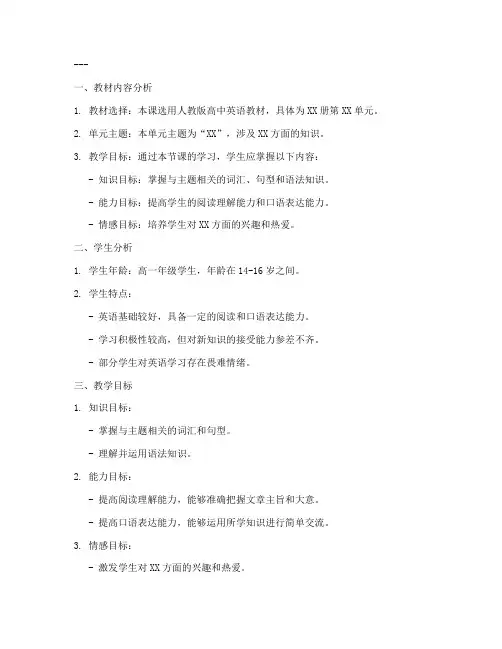
---一、教材内容分析1. 教材选择:本课选用人教版高中英语教材,具体为XX册第XX单元。
2. 单元主题:本单元主题为“XX”,涉及XX方面的知识。
3. 教学目标:通过本节课的学习,学生应掌握以下内容:- 知识目标:掌握与主题相关的词汇、句型和语法知识。
- 能力目标:提高学生的阅读理解能力和口语表达能力。
- 情感目标:培养学生对XX方面的兴趣和热爱。
二、学生分析1. 学生年龄:高一年级学生,年龄在14-16岁之间。
2. 学生特点:- 英语基础较好,具备一定的阅读和口语表达能力。
- 学习积极性较高,但对新知识的接受能力参差不齐。
- 部分学生对英语学习存在畏难情绪。
三、教学目标1. 知识目标:- 掌握与主题相关的词汇和句型。
- 理解并运用语法知识。
2. 能力目标:- 提高阅读理解能力,能够准确把握文章主旨和大意。
- 提高口语表达能力,能够运用所学知识进行简单交流。
3. 情感目标:- 激发学生对XX方面的兴趣和热爱。
- 培养学生的团队合作精神和自主学习能力。
四、教学重难点1. 教学重点:- 词汇和句型的掌握。
- 阅读理解能力的提高。
2. 教学难点:- 语法知识的运用。
- 口语表达能力的提高。
五、教学方法1. 讲授法:通过教师的讲解,帮助学生掌握重点知识和难点知识。
2. 讨论法:引导学生积极参与课堂讨论,提高学生的口语表达能力。
3. 练习法:通过大量的练习,巩固所学知识。
六、教学过程1. 导入(5分钟):- 利用图片、视频等多媒体手段,激发学生的学习兴趣。
- 提出与本节课主题相关的问题,引导学生思考。
2. 新课讲授(25分钟):- 讲解与主题相关的词汇和句型。
- 分析课文结构,帮助学生理解文章主旨和大意。
- 举例讲解语法知识,并引导学生进行练习。
3. 课堂活动(15分钟):- 小组讨论:分组讨论课文内容,分享学习心得。
- 角色扮演:学生分组进行角色扮演,提高口语表达能力。
4. 课堂小结(5分钟):- 回顾本节课所学内容,总结重点和难点。
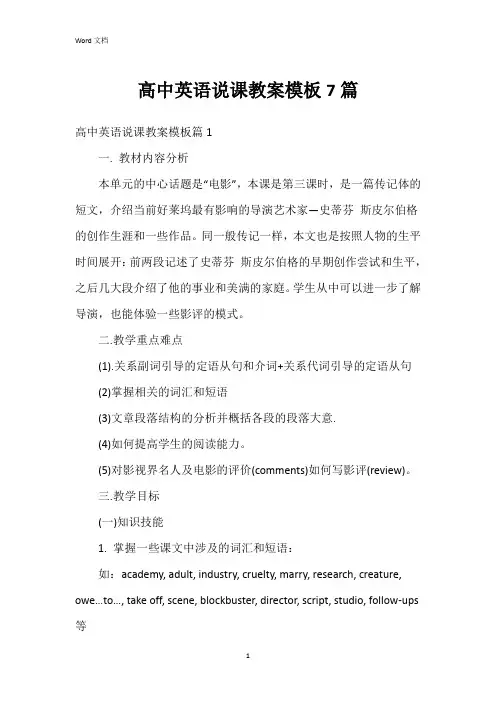
高中英语说课教案模板7篇高中英语说课教案模板篇1一. 教材内容分析本单元的中心话题是“电影”,本课是第三课时,是一篇传记体的短文,介绍当前好莱坞最有影响的导演艺术家—史蒂芬斯皮尔伯格的创作生涯和一些作品。
同一般传记一样,本文也是按照人物的生平时间展开:前两段记述了史蒂芬斯皮尔伯格的早期创作尝试和生平,之后几大段介绍了他的事业和美满的家庭。
学生从中可以进一步了解导演,也能体验一些影评的模式。
二.教学重点难点(1).关系副词引导的定语从句和介词+关系代词引导的定语从句(2)掌握相关的词汇和短语(3)文章段落结构的分析并概括各段的段落大意.(4)如何提高学生的阅读能力。
(5)对影视界名人及电影的评价(comments)如何写影评(review)。
三.教学目标(一)知识技能1. 掌握一些课文中涉及的词汇和短语:如:academy, adult, industry, cruelty, marry, research, creature, owe…to…, take off, scene, blockbuster, director, script, studio, follow-ups 等2. 学习掌握一些重点句子:如:this was a film in which … real actors… p31instead of …this was the moment when …took off. p31when asked about the secret about …he owes…to…p32after that it still took …before… p323. 学习、掌握关系副词when,where.,why 引导的定语从句及介词+关系代词引导的定语从句。
4. 通过本课训练使学生能够提高他们的阅读理解能力,通过一些重点词汇及短语掌握文章大意。
(二)情感态度1. 通过学习课文,培养学生了解、尊重异国文化,体现国际合作精神。
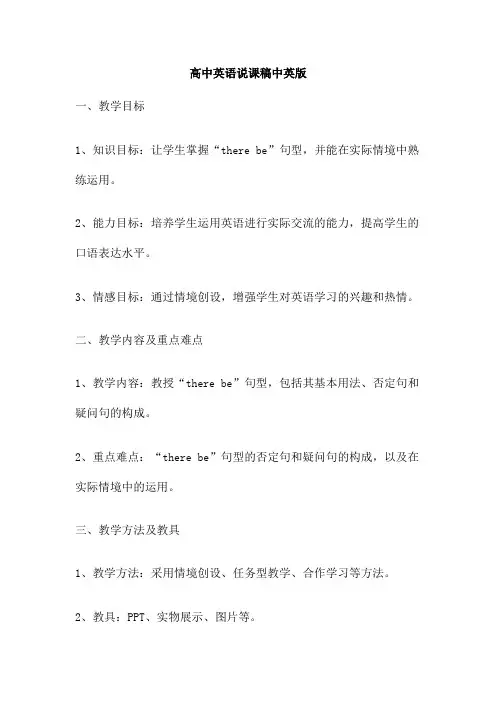
高中英语说课稿中英版一、教学目标1、知识目标:让学生掌握“there be”句型,并能在实际情境中熟练运用。
2、能力目标:培养学生运用英语进行实际交流的能力,提高学生的口语表达水平。
3、情感目标:通过情境创设,增强学生对英语学习的兴趣和热情。
二、教学内容及重点难点1、教学内容:教授“there be”句型,包括其基本用法、否定句和疑问句的构成。
2、重点难点:“there be”句型的否定句和疑问句的构成,以及在实际情境中的运用。
三、教学方法及教具1、教学方法:采用情境创设、任务型教学、合作学习等方法。
2、教具:PPT、实物展示、图片等。
四、教学步骤1、导入:通过展示一些物品,引导学生用“there be”句型进行描述。
2、新课教授:讲解“there be”句型的基本用法,并通过实例进行演示。
3、练习:让学生通过小组合作,运用所学句型进行情境对话。
4、反馈与纠正:听取学生的反馈,对出现的问题进行纠正。
5、巩固拓展:通过任务型教学,让学生在新的情境中运用所学知识。
五、评价与反馈1、评价方式:采用形成性评价和终结性评价相结合的方式。
2、反馈方式:通过观察学生的表现,给予及时反馈和指导。
六、作业布置1、用“there be”句型写一篇短文,描述自己的房间。
2、与家人或朋友进行情境对话,运用所学句型。
高中英语说课稿尊敬的各位领导和同事们,大家好!今天我要说课的内容是高中英语。
在接下来的时间里,我将分享我的教学理念、课程设计、教学方法和评估策略。
一、教学理念作为英语教师,我认为培养学生的语言综合运用能力是至关重要的。
在我的课堂上,我注重学生的主体地位,鼓励他们积极参与课堂活动,通过体验、实践、讨论和合作等方式学习和使用英语。
我也重视培养学生的自主学习能力,激发他们的学习兴趣和动力,让他们在英语学习中取得成功。
二、课程设计我的课程设计基于教材,但并不局限于教材。
我会根据学生的实际情况和需求,对教材进行适当的调整和扩展。
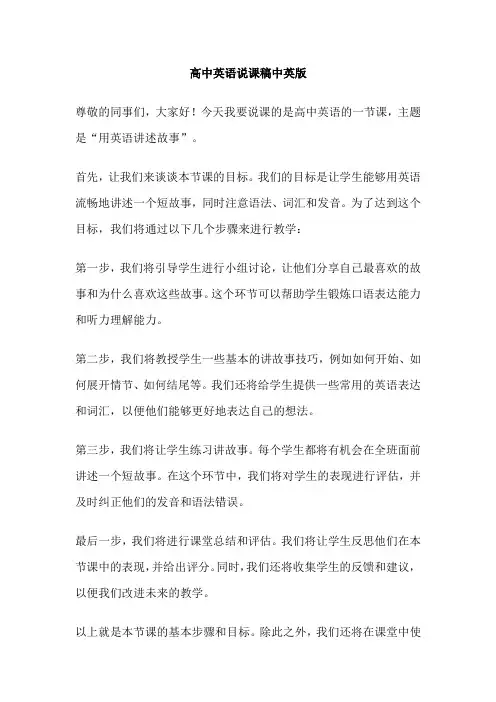
高中英语说课稿中英版尊敬的同事们,大家好!今天我要说课的是高中英语的一节课,主题是“用英语讲述故事”。
首先,让我们来谈谈本节课的目标。
我们的目标是让学生能够用英语流畅地讲述一个短故事,同时注意语法、词汇和发音。
为了达到这个目标,我们将通过以下几个步骤来进行教学:第一步,我们将引导学生进行小组讨论,让他们分享自己最喜欢的故事和为什么喜欢这些故事。
这个环节可以帮助学生锻炼口语表达能力和听力理解能力。
第二步,我们将教授学生一些基本的讲故事技巧,例如如何开始、如何展开情节、如何结尾等。
我们还将给学生提供一些常用的英语表达和词汇,以便他们能够更好地表达自己的想法。
第三步,我们将让学生练习讲故事。
每个学生都将有机会在全班面前讲述一个短故事。
在这个环节中,我们将对学生的表现进行评估,并及时纠正他们的发音和语法错误。
最后一步,我们将进行课堂总结和评估。
我们将让学生反思他们在本节课中的表现,并给出评分。
同时,我们还将收集学生的反馈和建议,以便我们改进未来的教学。
以上就是本节课的基本步骤和目标。
除此之外,我们还将在课堂中使用多媒体技术,例如PPT和视频等,以帮助学生更好地理解和掌握课程内容。
在结束本次说课之前,我想强调的是,我们的教学目标是让学生能够用英语流畅地表达自己的想法,同时提高他们的听力理解能力和语法水平。
因此,我们将注重学生的口语实践和技能培养,而不是简单的知识传授。
谢谢大家!Hello everyone, teachers! Today I am going to present a lesson on high school English, with the theme of "Stories in English". First of all, let's talk about the objectives of this lesson. Our goal is to enable students to fluently tell a short story in English, paying attention to grammar, vocabulary, and pronunciation. To achieve this goal, we will carry out teaching through the following several steps:Step one, we will guide students to discuss in small groups and share their favorite stories and why they like these stories. This link can help students improve their speaking and listening comprehension skills.Step two, we will teach students some basic storytellingtechniques, such as how to start, how to develop the plot, and how to end a story. We will also provide students with some commonly used English expressions and vocabulary to help them better express their ideas.Step three, we will let students practice telling stories. Each student will have the opportunity to tell a short story in front of the class. In this link, we will evaluate students' performance and correct their pronunciation and grammar errors in real time.The last step is classroom summary and evaluation. We will let students reflect on their performance in this lesson and give grades. At the same time, we will collect student feedback and suggestions to improve our teaching in the future.The above are the basic steps and objectives of this lesson. In addition, we will also use multimedia technology such as PPTs and videos in the classroom to help students better understand and master the course content.Before concluding this lesson, I would like to emphasize that our teaching goal is to enable students to fluently express their ideas in English, while improving their listeningcomprehension and grammar skills. Therefore, we will focus on students' speaking practice and skill development, rather than simple knowledge transmission.Thank you all!。
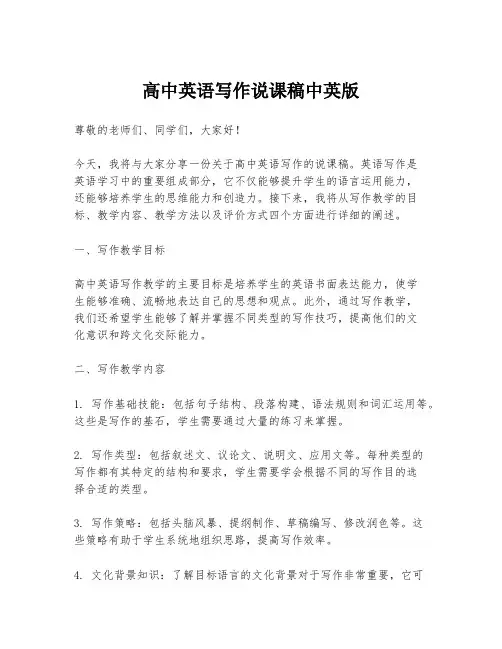
高中英语写作说课稿中英版尊敬的老师们、同学们,大家好!今天,我将与大家分享一份关于高中英语写作的说课稿。
英语写作是英语学习中的重要组成部分,它不仅能够提升学生的语言运用能力,还能够培养学生的思维能力和创造力。
接下来,我将从写作教学的目标、教学内容、教学方法以及评价方式四个方面进行详细的阐述。
一、写作教学目标高中英语写作教学的主要目标是培养学生的英语书面表达能力,使学生能够准确、流畅地表达自己的思想和观点。
此外,通过写作教学,我们还希望学生能够了解并掌握不同类型的写作技巧,提高他们的文化意识和跨文化交际能力。
二、写作教学内容1. 写作基础技能:包括句子结构、段落构建、语法规则和词汇运用等。
这些是写作的基石,学生需要通过大量的练习来掌握。
2. 写作类型:包括叙述文、议论文、说明文、应用文等。
每种类型的写作都有其特定的结构和要求,学生需要学会根据不同的写作目的选择合适的类型。
3. 写作策略:包括头脑风暴、提纲制作、草稿编写、修改润色等。
这些策略有助于学生系统地组织思路,提高写作效率。
4. 文化背景知识:了解目标语言的文化背景对于写作非常重要,它可以帮助学生更好地理解语言材料,并在写作中避免文化冲突。
三、写作教学方法1. 任务驱动法:通过设计真实或模拟的写作任务,激发学生的写作兴趣和动机,引导他们主动参与到写作过程中。
2. 合作学习:鼓励学生进行小组讨论和合作写作,通过交流和合作提高写作能力。
3. 反馈与评价:及时给予学生写作反馈,帮助他们认识到自己的不足,并指导他们如何进行改进。
同时,鼓励学生进行自我评价和同伴评价,培养他们的自主学习能力。
4. 多媒体辅助:利用多媒体工具,如PPT、视频、网络资源等,丰富写作教学内容,提高教学效果。
四、写作评价方式1. 形成性评价:通过课堂观察、小测验、草稿评价等方式,持续跟踪学生的学习进度和写作水平。
2. 总结性评价:通过作文考试、写作作品集等方式,综合评价学生的写作能力和学习成果。
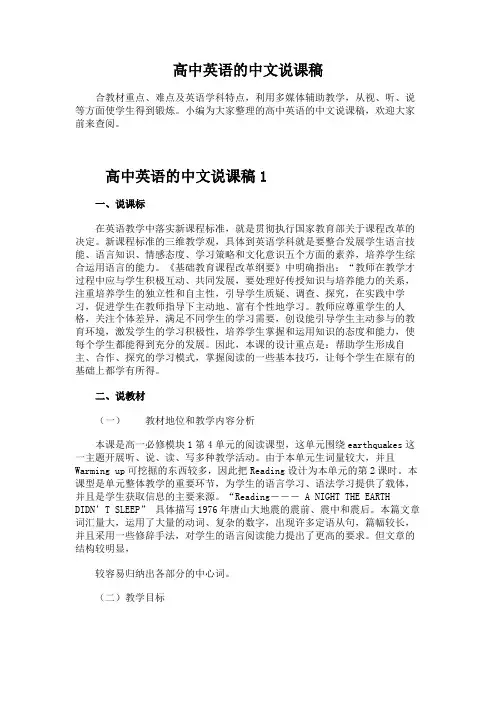
高中英语的中文说课稿合教材重点、难点及英语学科特点,利用多媒体辅助教学,从视、听、说等方面使学生得到锻炼。
小编为大家整理的高中英语的中文说课稿,欢迎大家前来查阅。
高中英语的中文说课稿1一、说课标在英语教学中落实新课程标准,就是贯彻执行国家教育部关于课程改革的决定。
新课程标准的三维教学观,具体到英语学科就是要整合发展学生语言技能、语言知识、情感态度、学习策略和文化意识五个方面的素养,培养学生综合运用语言的能力。
《基础教育课程改革纲要》中明确指出:“教师在教学才过程中应与学生积极互动、共同发展,要处理好传授知识与培养能力的关系,注重培养学生的独立性和自主性,引导学生质疑、调查、探究,在实践中学习,促进学生在教师指导下主动地、富有个性地学习。
教师应尊重学生的人格,关注个体差异,满足不同学生的学习需要,创设能引导学生主动参与的教育环境,激发学生的学习积极性,培养学生掌握和运用知识的态度和能力,使每个学生都能得到充分的发展。
因此,本课的设计重点是:帮助学生形成自主、合作、探究的学习模式,掌握阅读的一些基本技巧,让每个学生在原有的基础上都学有所得。
二、说教材(一)教材地位和教学内容分析本课是高一必修模块1第4单元的阅读课型,这单元围绕earthquakes这一主题开展听、说、读、写多种教学活动。
由于本单元生词量较大,并且Warming up可挖掘的东西较多,因此把Reading设计为本单元的第2课时。
本课型是单元整体教学的重要环节,为学生的语言学习、语法学习提供了载体,并且是学生获取信息的主要来源。
“Reading――― A NIGHT THE EARTH DIDN’T SLEEP”具体描写1976年唐山大地震的震前、震中和震后。
本篇文章词汇量大,运用了大量的动词、复杂的数字,出现许多定语从句,篇幅较长,并且采用一些修辞手法,对学生的语言阅读能力提出了更高的要求。
但文章的结构较明显,较容易归纳出各部分的中心词。
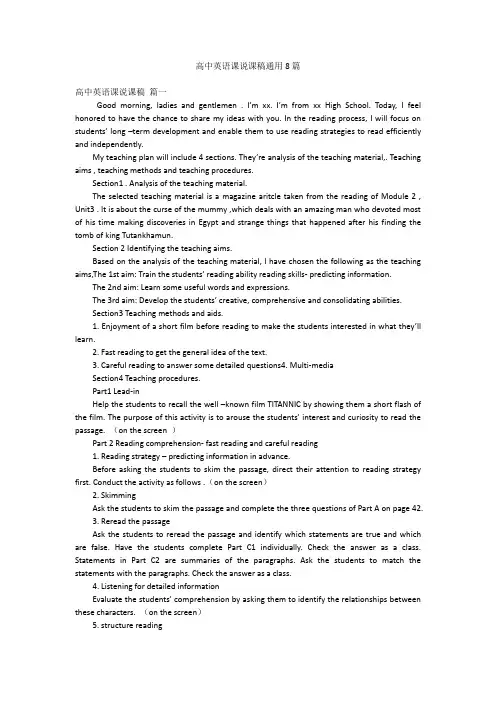
高中英语课说课稿通用8篇高中英语课说课稿篇一Good morning, ladies and gentlemen . I’m xx. I’m from xx High School. Today, I feel honored to have the chance to share my ideas with you. In the reading process, I will focus on students’ long –term development and enable them to use reading strategies to read efficiently and independently.My teaching plan will include 4 sections. They’re analysis of the teaching material,. Teaching aims , teaching methods and teaching procedures.Section1 . Analysis of the teaching material.The selected teaching material is a magazine aritcle taken from the reading of Module 2 , Unit3 . It is about the curse of the mummy ,which deals with an amazing man who devoted most of his time making discoveries in Egypt and strange things that happened after his finding the tomb of king Tutankhamun.Section 2 Identifying the teaching aims.Based on the analysis of the teaching material, I have chosen the following as the teaching aims,The 1st aim: Train the students’ reading ability reading skills- predicting information.The 2nd aim: Learn some useful words and expressions.The 3rd aim: Develop the students’ creative, comprehensive and consolidating abilities.Section3 Teaching methods and aids.1. Enjoyment of a short film before reading to make the students interested in what they’ll learn.2. Fast reading to get the general idea of the text.3. Careful reading to answer some detailed questions4. Multi-mediaSection4 Teaching procedures.Part1 Lead-inHelp the students to recall the well –known film TITANNIC by showing them a short flash of the film. The purpose of this activity is to arouse the students’ interest and curiosity to read the passage. (on the screen )Part 2 Reading comprehension- fast reading and careful reading1. Reading strategy – predicting information in advance.Before asking the students to skim the passage, direct their attention to reading strategy first. Conduct the activity as follows .(on the screen)2. SkimmingAsk the students to skim the passage and complete the three questions of Part A on page 42.3. Reread the passageAsk the students to reread the passage and identify which statements are true and which are false. Have the students complete Part C1 individually. Check the answer as a class. Statements in Part C2 are summaries of the paragraphs. Ask the students to match the statements with the paragraphs. Check the answer as a class.4. Listening for detailed informationEvaluate the students’ comprehension by asking them to identify the relationships between these characters. (on the screen)5. structure readingAsk the students to divide the text into a few parts according to the general idea of each paragraph .(on the screen)According to the diagram,I let the students make a summary of the text or let students fill in the blanks .(on the screen)Part 3 ConsolidationAsk the students to complete Part D and E individually . I can adapt Part D as the example shows . After completing Part D, the students are required to read the article in Part E and then fill in the missing words, check the exercises as a class.Part 4 Post –reading activities1. Ask the students to express their opinions on the following questions .(on the screen)2. Ask the students to write a summary about Howard Carter.3. Ask the students to focus on Part F and make up a dialogue as the example show. Make sure that all the students participate in the discussion.Ok , So much for my teaching plan ,Thank you for your careful attention.高中英语课说课稿篇二Good morning, everyone! I’m glad to be here to give my lesson plan presentation. The lesson plan I am going to talk about is the reading part of Unit 4 Wildlife Protection in the book NSEFC BOOK1. Now I’ll explain my lesson plan from the following aspects——analysis of teaching material, learning condition, teaching objectives, important and difficult points, teaching methods, teaching procure and blackboard design.Analysis of teaching material and learning conditionFirst, let’s come to the analysis of teaching material. The reading material is entitled How Daisy Learned to Help Wildlife. It talks about how Daisy learned the importance of wildlife protection through her communication with some animals in her dream. It is closely connected with this unit’s topic——the importance of wildlife protection. The passage is clearly organized by Daisy’s 3 trips in which she communicates with several endangered animals, and there are not so much new words in this passageNow let’s move on to the analysis of learning condition, students must be very familiar with the topic and interested in all kinds of animals. Students have acquired the basic reading skills, such as skimming, scanning, etc to deal with different reading tasks, and they can do some discussion in English. However, they are not familiar with the organization WWF mentioned in the passage, not clear with the author’s purposes of writing some sentences, and they may find it difficult to deal with some real problems by themselves concerning with wildlife protection.Teaching objectivesBased on the analyses of the teaching material and the learning condition, I will show you the teaching objectives.(1) Language Skills:1. Students can get the needed information about Daisy’s trip by applying different reading skills.2. Students can summarize the main ideas of each paragraph through skimming.3. Students can analyze the author’s purpose of writing sentences like “No rainforest, no animals, no drugs” and “And there are always WWF.”(2) Language Knowledge:1. Students can know more about why some animals are in danger and how to protect them.2. Students can know how to use the new words, such as mercy, importance, contain, etc.(3) Affective objectives:Students can realize the importance of wildlife protection.(4) Culture awareness:Students can know something about the organization WWF.(5) Learning strategy:1. Students can improve their communication strategy by discussing with classmates about protecting animals.2. Students can refer to the Internet to know more about wildlife protection.Key point and difficult points:Key points:(1) Students can improve their reading skills, such as summarizing, skimming, scanning, etc.(2)Students can get the main idea of the passage.(3) Students can know how to use the new words in the passage.Difficult Points:1. Students can summarize the main ideas of each paragraph.2. Students can get the implied meaning of some sentences in the passage.Teaching methodsAs for teaching methods, I’ll follow the interactive model to deal with the reading material and communicative approach to put what the students have learned into use.Teaching procedure:Then I’ll talk about the most important part of my presentation——teaching procedure.Warming-upThe first step is warming-up. It will cost 3 minutes. First, I’ll show my students a short clip of video about the endangered wildlife. Then, I’ll ask the students to name the endangered animals in it together with me and list more. This step is aimed to arise the students’ interest and get the students familiar with the topic——wildlife.Pre-readingThe second step is pre-reading. It will cost about 5 minutes with 2 activities. In the first activity, I’ll introduce something about the organization WWF to the students. The second activity is to ask students to give their reasons to the question “Why are some animals in danger?”。
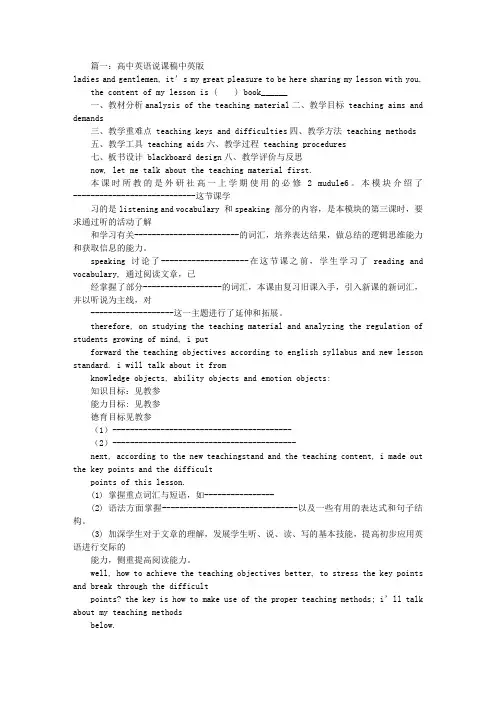
篇一:高中英语说课稿中英版ladies and gentlemen, it’s my great pleasure to be here sharing my lesson with you. the content of my lesson is ( ) book______一、教材分析analysis of the teaching material二、教学目标 teaching aims and demands三、教学重难点 teaching keys and difficulties四、教学方法 teaching methods五、教学工具 teaching aids六、教学过程 teaching procedures七、板书设计 blackboard design八、教学评价与反思now, let me talk about the teaching material first.本课时所教的是外研社高一上学期使用的必修 2 mudule6。
本模块介绍了----------------------------这节课学习的是listening and vocabulary 和speaking 部分的内容,是本模块的第三课时,要求通过听的活动了解和学习有关------------------------的词汇,培养表达结果,做总结的逻辑思维能力和获取信息的能力。
speaking 讨论了--------------------在这节课之前,学生学习了reading and vocabulary, 通过阅读文章,已经掌握了部分------------------的词汇,本课由复习旧课入手,引入新课的新词汇,并以听说为主线,对-------------------这一主题进行了延伸和拓展。
therefore, on studying the teaching material and analyzing the regulation of students growing of mind, i putforward the teaching objectives according to english syllabus and new lesson standard. i will talk about it fromknowledge objects, ability objects and emotion objects:知识目标:见教参能力目标: 见教参德育目标见教参(1)-----------------------------------------(2)------------------------------------------next, according to the new teachingstand and the teaching content, i made out the key points and the difficultpoints of this lesson.(1) 掌握重点词汇与短语,如----------------(2) 语法方面掌握-------------------------------以及一些有用的表达式和句子结构。
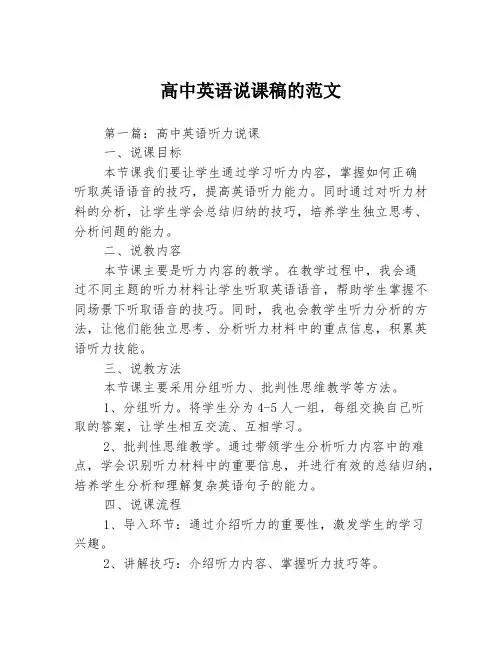
高中英语说课稿的范文第一篇:高中英语听力说课一、说课目标本节课我们要让学生通过学习听力内容,掌握如何正确听取英语语音的技巧,提高英语听力能力。
同时通过对听力材料的分析,让学生学会总结归纳的技巧,培养学生独立思考、分析问题的能力。
二、说教内容本节课主要是听力内容的教学。
在教学过程中,我会通过不同主题的听力材料让学生听取英语语音,帮助学生掌握不同场景下听取语音的技巧。
同时,我也会教学生听力分析的方法,让他们能独立思考、分析听力材料中的重点信息,积累英语听力技能。
三、说教方法本节课主要采用分组听力、批判性思维教学等方法。
1、分组听力。
将学生分为4-5人一组,每组交换自己听取的答案,让学生相互交流、互相学习。
2、批判性思维教学。
通过带领学生分析听力内容中的难点,学会识别听力材料中的重要信息,并进行有效的总结归纳,培养学生分析和理解复杂英语句子的能力。
四、说课流程1、导入环节:通过介绍听力的重要性,激发学生的学习兴趣。
2、讲解技巧:介绍听力内容、掌握听力技巧等。
3、分组听力:让学生进行分组听力。
4、批判性思维教学:通过带领学生分析听力内容中的难点,学会识别听力材料中的重要信息,并进行有效的总结归纳,培养学生分析和理解复杂英语句子的能力。
5、总结巩固:通过总结教学内容,帮助学生深化英语听力技能。
五、说教体会本节课主要是针对英语听力技能进行教学,通过讲解技巧、分组听力等具体手段,情于激发学生的英语学习兴趣,提高学生的英语听力能力。
同时,本课程也通过批判性思维教学,帮助学生深度理解听力材料中的难点,培养学生分析和总结归纳的能力。
教师应注意在教学中注重不同层次学生的教学差异,针对学生存在的问题进行及时的分析和解决,确保教学效果最大化。
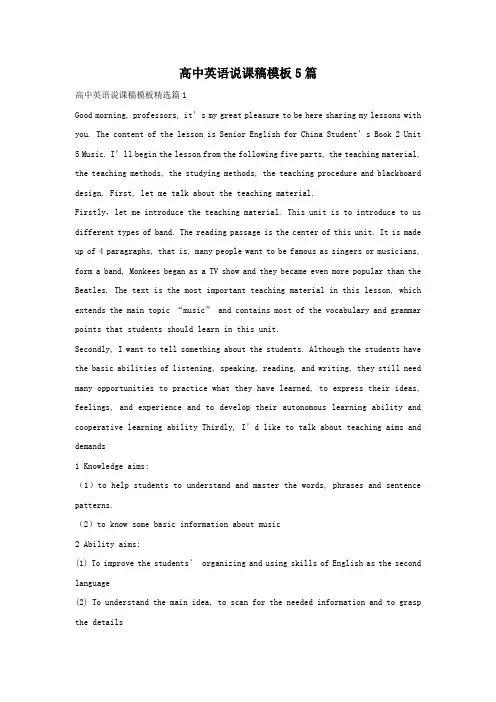
高中英语说课稿模板5篇高中英语说课稿模板精选篇1Good morning, professors, it’s my great pleasure to be here sharing my lessons with you. The content of the lesson is Senior English for China Student’s Book 2 Unit 5 Music. I’ll begin the lesson from the following five parts, the teaching material, the teaching methods, the studying methods, the teaching procedure and blackboard design. First, let me talk about the teaching material.Firstly,let me introduce the teaching material. This unit is to introduce to us different types of band. The reading passage is the center of this unit. It is made up of 4 paragraphs, that is, many people want to be famous as singers or musicians, form a band, Monkees began as a TV show and they became even more popular than the Beatles. The text is the most important teaching material in this lesson, which extends the main topic “music” and contains most of the vocabulary and grammar points that students should learn in this unit.Secondly, I want to tell something about the students. Although the students have the basic abilities of listening, speaking, reading, and writing, they still need many opportunities to practice what they have learned, to express their ideas, feelings, and experience and to develop their autonomous learning ability and cooperative learning ability Thirdly, I’d like to talk about teaching aims and demands1 Knowledge aims:(1)to help students to understand and master the words, phrases and sentence patterns.(2)to know some basic information about music2 Ability aims:(1) To improve the students’ organizing and using skills of English as the second language(2) To understand the main idea, to scan for the needed information and to grasp the details3 Emotional aims:(1) Help students understand different type of music and how to form a band(2) Develop students’ sense of cooperative learningFourthly, teaching key points is1. To help the students get a general idea of the whole passage, and some detailed information and language points as well.2. To understand how Monkees formed, developed and succeed. Teaching difficult points is1. The students use their own words to express their own ideas.2. the prep+ whom/which attribute clauseAccording to the analysis above, I’ll try to use the following theories to make students the real master of the class while the teacher myself the director. a. Communicative Language TeachingLanguage is used for communication. It’s learner-centered and emphasizes communication and real-life situations.b. Task-based Language TeachingA task resembles activities which our students or other people carry out in everyday life, Learners should be given opportunities to reflect on what they have learned and how well they are doing.c. Computer Assisted Language TeachingLanguage learning needs a context, which can help the learners to understand the language and then can product comprehensible output, so computer has the advantages to make the materials attractive.Part 3 Learning MethodsTask-based, self-dependent and cooperative learningPart 4 Teaching ProcedureStep One Lead-in“Interest is the best teacher.” Therefore, at the very beginning of the class, I should spark the students’ mind to focus on the centre topic “the band”. I’ll play some different type of music to attract their attention and then bring somequestions.Question:What kind of music they like?Which band they know best?The answers must relate to band. After this, the students will be eager to know something about band and this is the very time to naturally lead the class into Step 2Step 2 Reading for information: skimming and scanning In this step, I use Task-based Language Teaching method, which can give students a clear and specific purpose while skimming and scanning the context.Task 1 General ideaThe students will be asked to just glance at the title and the pictures of the passage, and then guess what they will read in the text. And they’ll be divided into groups of four to have a discussion.The purpose is to inspire the students to read actively, not passively. In addition, the task is to develop the students’ reading skill by making prediction and to encourage the students to express their thoughts in English and cooperate with each other.Task 2 Main idea of each paragraphCooperative learning can raise the students’ interest and create an atmosphere of achievement. Based on this theory, I divide the whole class into 4 groups to skim the whole text and get the main idea of each paragraph.Step 3 Reading for comprehensionThe purpose of reading is to get the correct and useful information. Students should not only have a high speed of reading but also have a correct understanding of details. Therefore the following practices on Page 35 can help check the situation.Step 4 Solving difficult language problems through readingIt’s important for language learners to learn important rules ofgrammar and use these rules to solve problems in reality. In the previous process of reading, the students must come across some difficult language obstacles, so it’s necessary for us to discuss and explain. This period of time belongs to students. They can ask any questions they come across in the process of learning. I’ll explain the questions and difficulties. The purpose of this is improving the students “questioning spirit” and dealing with the difficulties.Step 5 ConsolidationLanguage is learnt by communicating. It is my job to create an atmosphere for students to use the language. Here I design 2 activities 1 Reading for comprehensionI’ll ask 4 students to read each paragraph, and then do the exercise following the text. I think it’s a good way to review what they have learned.2 DiscussionDuring making discussion, the students will deepen their understanding of the main idea of the passage.a. Why Monkees can be successful? Give reasons.b. What’s the most important thing for a successful band? Why? Step 6 Homework Ask the students to write down sth about their favorite singers, band or music and list the reasons. The assignment enables the students to search various information resources, which can widen their view and continue to inspire their enthusiasm of learning.Part 5 Blackboard designUnit 4 MusicPassage The Band That Wasn’tTopic Sentences:1. Many people want to be famous as singers or musician2. Form a band3. Began as a TV4. They became even more famous than the BeatlesDiscussion:a. Why Monkees can be successful? Give reasons.b. What’s the most important thing for a successful band? Why?In my opinion, the blackboard design can reflect the teacher’s ability of masteringthe text and leading the students to master the text easily. In this text, the design is not easy to write. I write the topic sentences on the blackboard, in order to tell the students that this is of the importance in this class. I want to make the design inductive, instructive and artistic.高中英语说课稿模板精选篇2Lesson Plan PresentationHello, everyone. I’m glad to be here to give my lesson plan presentation. The lesson plan I’m going to talk about is the reading part from NSECS book 1 unit 1 Friendship. Now, I’d like to explain how to teach and why to do so from the following aspects: the analysis of teaching material and learning condition, the teaching objectives, the teaching method and teaching aids, the teaching procedures, and the blackboard design.First, I’d like to talk about the analysis of teaching material and learning condition.The title of the text is “Anne’s Best Friend”. It mainly talks about a Jewish girl, Anne, who treated her diary as her best friend when she and her family hid in a shelter to escape from the killing of Nazis. The text has tow parts, the first part is about the background of Anne’s diary, and the second part is about the content of Anne’s diary. The key point of the text is that students can use different kind of reading skills like prediction, scanning and skimming to get good understanding of the text. The difficult point is that students can summarize the main idea of the whole text and each paragraph.As for the students, they are in grade 9 in high school, and they have learned English for more than 7 years. They have a certain vocabulary store, while they lack the training of reading skills. They are interested in the topic of friendship because they attach much importance to friendship. And they can make some discussion in English.According to the analysis of teaching material and learning condition, I make out the following teaching objectives.First, language skills: students can use reading skills like prediction, skimming and scanning to read the text.Second, language knowledge: students can learn some new words and new phrases, such as power, on purpose, in order to, etc. and students can be familiar with the topic of friendship.Third, learning strategy: students will learn to study and solve problems by cooperation and communication.Fourth, affective objectives: students will value friendship more and cherish what they have.Last, cultural awareness: students will know more knowledge about the history of World War Ⅱ, especially the suffering of Jewish people during the war.Then, I’ll talk about the teaching method and teaching aids. I adopt communicative approach. And the teaching aids are blackboard and PPT.Now, I will focus on the teaching procedures. There are 4 steps.Step 1 is warming up. It will cost 3 minutes. In this part, I will show students an English song “Forever friend”. Before listening, I will ask students to think about the question “What’s the song about?” so that they will listen to the song with purpose. After they finish the listening, they will know that the song is about friendship. It will naturally lead in the topic of the text. What’s more, students are interested in listening to music, the song will arouse students interest and activate the class atmosphere.Step 2 is pre-reading, it will cost 5 minutes. First, I will ask students to read the title of the text and ask them “Do you know Anne? Who is she?” if students don’t know, I will tell them that Anne is a Jewish girl who survived in the World War Ⅱand I will talk about the suffering of Jewish people during the war with some related pictures. After students have the background knowledge of the text, I will ask them to look at the title and the picture of the text to predict the content of the text. The purpose of prediction is to make students read the text more carefully during the reading process. They will concentrate more to check their prediction so that they can get their mind closer to the theme of the text.Step 3 is while reading. It will cost 25 minutes. There are there activities.In activity 1, I will ask students to skim the text to get the main idea of the text and each paragraph. Because it’s a little difficult for students to summarize the main idea, I will give them some multiple choices to choose, it will reduce the degree of difficulty. The purpose of this activity is to train students’ reading skill of skimming, and they can get the general idea of the text.In activity 2, I will ask students to scan the text to fill in some blanks. The purpose of this activity is to train students’ reading skill of scanning, and they can get some detailed information of the text.Activity 3 is close reading. In this part, I will first explain some new expressions that may cause difficulty in students’ comprehension, such as go through, on purpose, in order to, etc. so that they read the text smoothly. Then I will ask students to answer the questions in exercise 2. After answering these questions, students will have a better understanding of the whole text. Next, I will ask students to work in pairs to use some adjectives to describe Anne’s feelings as she was looking out at the night sky. Then I will ask some students to come to the blackboard to write the adjectives. After this activity, students will have a better understanding of Anne’s feelings.Step 4 is post reading. It will cost 12 minutes. In this part, I will hold a group discussion. I will set a situation to students. That is “imagine you have to go into hiding like Anne and her family, what will you miss most? Why?” I will ask students to work in 4 to have a discussion. After discussion, I will ask some students to report their groups’ opinions and then I will write them on the blackboard. The purpose of this activity is to cultivate students’ spirit of cooperation. And after the discussion, students will learn to cherish what they have.Then, I will talk about the homework. I will ask students to write a short passage about what they will miss most and why based on the former discussion in class. Ok, now, please look at here, this is my blackboard design.miss reasonsThis is all my lesson plan presentation, thank you very much!高中英语说课稿模板精选篇3Hello,everyone! I’m glad to be here to present my lesson plan, the lesson plan I will talk about is from NSEFC Book 2 Unit 4 Wildlife Protection, peariod1 How Daisy Learned to Protect Wildlife. I will explain how to teach and why to do so in the following aspects: the analyses of teaching material, learning condition, teaching objectives, the important points and difficult points, teaching methods, teaching procedure and blackboard notes.Fistly, I’d like to present my understanding of teaching material. It’s the first period in this course. The lesson is mainly reading course. Its topic is about the importance of wildlife protection and how to protect the endangered wildlife. Ss are very familiar about this topic, so they will talk about it freely.This is all my understand of teaching material. Next, let’s move on to learning condition. My Ss are supposed to be grade1 in high school. Most of them have been learning English for seven years and their enthusiasm for English is quite high. They can express their own ideas in English. But they are lack of reading skills. Based on the analyses of teaching material and learning condition,I’d like to propose the teaching objectives, the important points and difficult points.(1) language knowledgeAfter the class, the Ss can master the new words in this lesson, for example: carpet, respond, distant…(2) language skillThis is reading course, so after class the Ss should master the reading skills: prediction, skimming and scanning. What’s more, they should know how to summary the main idea of the passage from the key words and sentence.(3) Affective objectivesAfter class, the Ss should understand the importance of wildlife protection. And they know how to protect and can take actions to protect animals.(4) Culture awarenessSs will know more about the agonization for wildlife protection, for example, WWF.And they will understand we all have responsibility for wildlife protection. (5) Learning strategySs will be able to learn both individually and cooperatively through activities. Now let’s move on to the important and difficult pointsThe Ss talk the topic “wildlife protection” freely and master the reading skills —prediction, skimming and scanning. These are also the difficult points for Ss. As for teaching method, I mainly adopt communicative approach.Here comes the most important part of my presentation--- teaching precedure. I divide it into 5steps: warming-up, pre-reading, while-reading, post-reading and homework. Step1 warming-up. It will cost 5m. Activity1, I will play a vedio about endangered animals. After that, I will ask Ss to talk about why they are in danger of dissapearing. Ss will give some reasons. There will be some new words mentioned, such as wild, die out, disappear… I will explain them. Then I will say: “These animals now are protected by some wildlife parks, such as Word Wildlife Found(WWF).” I will introduce more information about WWF. In this activity, Ss will know reasons of the dissapearance of wildlfe and get some knowledge about WWF. And they will get familiar about the following reading.Step2 pre-reading. It will cost 5m.Activity1, I will ask Ss to predict what the passage will talk about the title “How Daisy learned to help wildlife”. In this activity, Ss will learn the reading skill —predicting.Step3while-reading. In this step I will divide it into three activities, and it will cost 25m.Activity1 Skimming 5mIn this activity, I will show main idea of each paragraph, but not in order. Ss should skim each paragraph and match them. I will imply that the main idea always appear in the first or the last sentence, but some will apear in the middle. In this activity, Ss will learn how to find the main idea of each paragraph using the reading skill —skimming.Activity2 Scanning 12mIn this activity, I will make a table about Daisy’s three visits to wildlife. This table will refer to animals’ living conditions and the result of their lives. I will ask Ss to scan the whole passage, and find the information based on the table. They should finish the table in group of 4 members and after their discussing I will ask 2 or 3 groups to report their results. In this activiy, Ss will learn the reading skill—scanning, and master some new words and phrases, such as in relief, burst into laughter, mercy, certain and so on. They can find the important information from each paragraph and get the consciousness of team work.Activity3 summarize 3mSs will summarize the main idea of the whole passage easily in group. From this activity, Ss will learn to analysize each paragraph and finally get the main idea. Activity 4 retelling 5mI will ask Ss to retell the passage in pair according to Daisy’s three visits. Then I will ask two Ss to retell in front of the class. In this activity, Ss can use the key words and sentences to retell the whole story and consolidate what they have learned.Step4 post-reading. It will cost 8. In this step, Ss will make discussion about ways to protect wildlife and express their own ideas with their previous knowledge. After 5m’s discussion, I will ask two or three Ss to show their ideas. In this step, Ss will not only share their ways to protect wildlife, but also practice their speaking. The last step is homework. I will ask Ss to find the persuasive sentences in the passage. They are asked to surf the Internet to find more ways to protect wildlife, and then write three suggestions to WWF to protect wildlife. Ss will make preparation for the next course--- persuasive writing.That’s all for the teaching procedure. And here is my blackboard note. On the right side, there are the words and expressions. In the left, there is the table about Daisy’s three visits.That all for my lesson plan presentation, thanks for your attention. Blackboard Note:Unit 4 How Daisy Learned to Protect WildlifeParagraph(main idea ) Animal Situation ResultPara.1 Tibet Antelope Be hunted Numbers are descreasingPara.2 ………Para.3/4 ……. ….carpetfurdistantmercycertainburst into laughterin relief…高中英语说课稿模板精选篇4Good afternoon, teachers, It’s my great pleasure to be here sharing my lesson with you. The content of my lesson is Senior English Book unit 1(A student of African wildlife/Why not carry on the good work)I’ll be ready to begin this lesson from five parts. Analysis of the teaching material, the teaching methods, the studying methods, the teaching procedure, and Blackboard design. First, let me talk the teaching material. Part 1 Teaching Material:This unit is about(Great women and their achievements , Important people, history and methods of agriculture, Different types of English humor ,Culture differences and communication Different types of theme park)By studying of this unit, we’ll enable the students to know some great women and their achievement and what makes the great women successful The knowledge of farming and Dr Yuan Longping’ achievement And chemical farming and organic farming. Charlie Chaplin and his funny and encouraging humor People from different area have different body language and use the right body language to showing our feelings. Theme park not only provide fun but also provide various knowledge and exciting experience. this lesson not only teach the students to learn the related material about (1) thegood character to be a successful person (2)Yuan longping’s scientific research spirit and attitudes toward life The disadvantage of using chemical fertilizers and how to increase production in organic farming. (3)Charlie Chaplin and his humor English jokes (4)Different body language and the similarities in body language which make the others understand our feelings. (5)Theme park but also learning ability in English .A: If Ss can learn it well, it will be helpful to make the Ss learn the rest of this unit well. B: It provides all-around practice about listening, speaking, reading and writing revolve around the topic, it is the expansion of this unit and give Ss a space to use the language So it plays an important part in the English teaching in this unit.(As we know ,reading belongs to the input during the process of the language learning. The input has great effect on output , such as speaking and writing . )According to the new standard curriculum and the syllabus (新课程标准和教学大纲), after studying the teaching material and analyzing the rule of children’s growing of mind, I think the teaching aims are the followings: 1.Knowledge objects: (1)the students can hear, read, and use the main sentence patterns. (2) the students can understand the content of the lesson: (3) the students can use the patterns to express their thoughts in proper situation and learn how to describe people with adjective. Ability objects: Ability objects of this section are (1)To develop the Ss’ abilities of listening, speaking, reading and writing. Especially speaking and writing ability.(2) To train the Ss’ ability of working in pairs. (4) To improve the Ss’ reading abilities ,especially their skimming and scanning ability. 3.Emotion objects: By reading A Student of African wildlife /why not carry on the good work, students can learn from (1)Jane Goodall in at least two aspects: one is what is the human way to study animal; the other is that it was her great personality-universal love and mercy that made her successful. Lin Qiao zhi in at least two aspects: one is what is the human way to help poor patients; the other is that it was her great personality-universal love and mercy that made her successful. (2)Dr Yuan Long ping his scientific research spirit and attitudes toward life This passage what ischemical and organic farming and their advantage and disadvantage.高中英语说课稿模板精选篇5Good afternoon,teachers. It’s my great pleasure to be here sharing my teaching ideas I’ll begin the lesson from the following four parts:Analyzing teaching materialThe teaching methodsThe studying methodsThe teaching proceduresand while presenting these parts I will do the blackboard writing properly. Ok now I am going to start from the first part “Analyzing teaching material”This unit is about It is made up of paragraphs.The teaching aim of this lesson is to help students to understand and master the words, phrases and sentence patterns on the basis of understanding the text. The ability aim is to improve the students’ organizing and using skills of English and to retell the whole text in their own words.The emotional aim is to help students understand and to developstudents’ sense of cooperative learning.Then the teaching key points is to help the students get a general idea of the whole And the teaching difficult points is to make students use their own words to express According to the analysis above, I’ll try my best to carry out the following theories while dealing with this lesson:To make students the real masters of the class while I just act as a director. To combine the language structure with the language functions.And to make students receive some moral education while they are learning language. In order to achieve my goal, I will use the following teaching methods:The first teaching method I will use is communicative approach, since language is used for communication. Communicative approach is learner-centered and emphasizes communication and real-life situations.The second teaching method I would like to use is task-based approach. A taskresembles activities which our students or other people carry out in everyday life. Learners should be given opportunities to reflect on what they have learned and how well they are doing.The third teaching method I want to use is computer assisted language teaching. Computer plays an important role to make the materials attractive. It can also help the learners to understand the language and then produce comprehensible output. And in order to practice my teaching methods better, the following teaching aids will be used:A projector, a tape recorder, multimedia and of course the blackboard.And then, I would like to talk about the studying methods. As students are poor in cooperative learning skill, many students are not active in English class, and even some of them don’t like English. Therefore, I will have the students learn English in a much more relaxed atmosphere. The learning process of students is from seeing, thinking, and speaking. So, to make the students get the knowledge actively, cooperative learning and task-based learning will be used.Next, I will talk about the teaching procedure. To train the students’ ability of listening, speaking, reading and writing, I have designed the following steps. Step 1 Lead-inAt the very beginning of the class, I will make the students have a free talk about and then discuss the questions in pre-reading on page . The purpose of this step is to arouse the students’ learning interest. After a discussion about the questions, the students will be eager to know something about and it’s the very time to naturally lead the class intoStep 2 Listening comprehensionsIn this step, I will write several questions before listening to the text:And then I will make the students answer the questions after listening to the tape. The purpose of this step is to train and improve the students’ listening ability . Step 3 skimming and scanningIn this step, I will give the students two tasks . The first task is to get the general idea, the task is to develop the students’ reading skill by making prediction andto encourage the students to express their own thoughts in English. The second task is to get the main idea of each paragraph. I will divide the whole class into several groups to skim the whole text and get the main idea of each paragraph. The purpose of this task is to improve the students’ fast reading skill and cooperate with each other.And then guide Ss to read the material carefully and take some important notes, then answer the following questions in P.Step 4 Retelling the passageLanguage is learned by communicating. It’s my job to creat an atmosphere for students to use the language. The students discuss in their group and then choose a reporter to share to the whole class.Step 7 ConsolidationIn this activity, I will ask some students to read each paragraph, and then do the exercise following the text.Step 8 make a summaryI will go through the important points and difficult points of this lesson with the students once again. And of course, the language points on the blackboard will be mentioned as well.And now let’s move to the last stepStep 9 Homework1. Read the passage as frequently as you can2. Find out some words and sentences you think are beautiful and recite them. Purpose of my design: Homework is so important and necessary for to master the knowledge they learned after class. It will check whether the Ss achieve the teaching aims.That’s all of my teaching ideas about this lesson. Thanking you for your listening.。

高中英语说课稿(中英对照)说课稿(InterpretationGood morning,ladies and gentlemen.It’s my great honor to stand heresharing my lesson with you.I have divided my presentation into ten parts.Analysis of the teaching material,analy sis of the students,teaching aims,teaching methods,teaching aids,teaching important points and difficult points,teaching procedures,homework and blackboard design.一、教材分析(Analysis of the teaching material是外研社版高中英语必修第模块Reading部分。
通过上一节课的学习,学生已经掌握了本课的生词及与这一课相关的一些知识,这为本次课的教学起到了很好的铺垫作用。
本课主要是围绕这一主题展开听说读写等多种教学活动,这与学生的日常生活息息相关,在本模块中有着不可替代的位置,在整本教材中也有着非常重要的作用。
(The content of my lesson is senior high school Englishbook,book 3,module4 reading part.Before this class,the students havelearned the new words and expressions of this module.They also havelearned some related knowledge about this topic.It plays a very importantrole in this class.This passage is about.By studying thispassage,students can.At the same time,they canThis lesson plays an important part in this unit.It is also an importantlesson in this book.二、学生分析(Analysis of the students教学对象是高学生,他们已经有一定的英语基础,而且有一定的认知能力,他们的求知欲望不仅仅只限于书本上的知识。
高中英语说课稿中英结合尊敬的各位老师,同学们,大家好!今天,我将为大家带来一节高中英语的说课演示。
在这节课中,我们的目标是提高学生的英语听说能力,同时加深他们对英语文化的理解。
课程的主题是“Globalization and Cultural Identity”,即“全球化与文化认同”。
首先,让我们来看一下课程的教学目标。
通过本节课的学习,学生将能够:1. 理解并讨论全球化对不同文化的影响;2. 描述自己文化的特点,并与他人进行比较;3. 提高英语口语表达能力和听力理解能力;4. 增强跨文化交流的意识和尊重多样性的价值观。
接下来,我会简要介绍课程的教学内容和教学步骤。
Step 1: Warming-up and Lead-in (5 minutes)课程开始时,我会用一个简短的视频剪辑来吸引学生的注意力,视频内容是关于世界各地不同文化的节日庆典。
这个活动旨在激活学生的背景知识,为接下来的讨论做好铺垫。
Step 2: Presentation (15 minutes)接下来,我会用英语介绍全球化的定义、历史和对文化的影响。
我会使用PPT展示一些关键词汇和短语,如“globalization”,“cultural identity”, “cultural exchange”等,并解释它们的含义。
此外,我会引入一些真实的例子,比如跨国公司如何影响当地文化,以及不同文化如何通过电影、音乐和食物等方式传播。
Step 3: Listening Practice (10 minutes)在听力练习部分,学生将会听到一段关于全球化影响的英语访谈录音。
录音中会有两位来自不同文化背景的人士讨论他们对全球化的看法。
学生需要集中注意力,捕捉信息,并回答一些关于录音内容的问题。
Step 4: Group Discussion (15 minutes)随后,学生们将分成小组,用英语讨论以下问题:“全球化对你自己的文化有什么影响?”和“你认为如何在全球化的背景下保持文化的独特性?”这个环节旨在鼓励学生表达自己的观点,并学会倾听和尊重他人的不同意见。
高中英语说课稿篇一:高中英语说课稿精选(共6篇)篇一:高中英语说课稿范文两篇高中英语说课稿范文两篇前言:在英语教学中落实新课程标准,就是贯彻执行国家教育部关于课程改革的决定。
新课程标准的三维教学观,具体到英语学科就是要整合发展学生语言技能、语言知识、情感态度、学习策略和文化意识五个方面的素养,培养学生综合运用语言的能力。
开展课堂探究是培养学生综合语言运用能力的最佳手段。
所以在我的教学设计里,每一个教学活动中都有情景创设,学生探究,学生处理问题和巩固训练等环节。
一、教学内容分析(一)知识背景及新课程、新教材本单元围绕考古这一主题开展听、说、读、写多种教学活动。
旅游作为当今社会人们最感兴趣的话题在英语学习占有非常重要的位置。
名胜古迹是旅游的重点内容之一,名胜古迹中的许多发现都来自于考古工作。
所以archaeology也是一个非常贴近生活、具有时代性、可挖掘性的教学主题。
本单元所选的语言素材涉及中外名胜,有利于学生了解外国文化,增强世界意识。
正如新课程标准中的教学建议所提:学习考古有利于“拓展学生的文化视野,发展他们跨文化交际的意识和能力”;在利用现代教育技术观看历史教育片的过程中,“拓宽了学生学习和运用英语的渠道”;同时本单元的教学对教师本身历史文化修养、广阔的知识面等方面有非常高的要求,体现了师生共同不断更新知识结构以适应现代社会发展对英语课程的要求的“与时俱进”的理念和思想。
(二)教学重点难点1.利用已有知识谈论石器时代、青铜器时代、汉朝、唐朝等时代人们的饮食起居、文化娱乐、生产工具等,为以后阅读英国的《巨石王》和中华文明的起源奠定基础。
2.调动学生的积极性,组织他们利用表达好奇功能结构谈论他们所感兴趣话题。
3.听力是这一课的难点。
听力材料介绍是古代法国人用来射箭的一种武器。
材料长,对武器的结构的解释比较复杂。
但是学生听过材料后能够顺利地完成课本上的练习。
这里不要求学生理解细节,只要能完成练习就行。
高中英语中文说课稿一等奖尊敬的评委老师、各位同仁:大家好!今天,我有幸在此为大家说课,我的课题是高中英语教材中的一篇经典阅读文章——《The Power of One》。
这篇文章不仅语言优美,内容丰富,而且蕴含着深刻的人生哲理,对于培养学生的英语阅读能力和思维品质具有重要的意义。
一、教学目标在设计这堂课的教学目标时,我主要考虑了以下几个方面:1. 知识与技能:学生能够理解文章的主旨大意,掌握文章中的关键词汇和句型,并能够运用这些语言知识进行简单的复述和讨论。
2. 过程与方法:通过小组合作学习,培养学生的合作意识和交流能力;通过批判性思维训练,提高学生的分析和评价能力。
3. 情感态度与价值观:引导学生思考个人力量的重要性,激发他们为自己的梦想和目标而努力。
二、教学内容与分析《The Power of One》这篇文章讲述了一个普通少年通过自己的努力和坚持,最终实现梦想的故事。
文章语言简洁而有力,情节紧凑,富有启发性。
1. 词汇与句型:文章中出现了一些描述人物性格和行为的词汇,如“determined”, “perseverance”, “overcome obstacles”等,这些词汇对于学生理解和表达个人奋斗的主题非常有帮助。
同时,文章中的复合句和并列句也是学生需要掌握的重要语法点。
2. 文章结构:文章采用了经典的叙事结构,分为引入、发展、高潮和结局四个部分。
这种结构清晰,易于学生把握文章脉络。
三、教学方法与手段为了有效地实现教学目标,我将采用以下教学方法和手段:1. 导入新课:通过播放一段关于个人奋斗和成功的视频,激发学生的兴趣,并引出文章主题。
2. 阅读教学:采用“快速阅读—精读—复述”的教学模式。
首先,让学生快速浏览文章,抓住主旨大意;然后,通过精读,解决词汇和句型难点;最后,通过小组合作,让学生尝试复述文章内容。
3. 互动讨论:在学生对文章有了基本理解后,组织课堂讨论,让学生分享自己对于“个人力量”的看法和体会。
高中英语完形填空英文说课稿范文【中英文版】Introduction:Today"s lesson is focused on the skill of Cloze Test, an essential component in high school English exams.This exercise not only evaluates students" vocabulary knowledge but also their comprehension and grammatical skills.Let"s delve into a sample teaching script for this activity.引言:今天的课程重点是完形填空技能,这是高中英语考试中的一个重要组成部分。
这项练习不仅评估学生的词汇知识,还考查他们的理解和语法技能。
让我们深入了解一下这个活动的示范教学脚本。
Body:To begin with, I will introduce the context of the passage, setting the stage for students to grasp the overall theme.Then, we"ll proceed with the first question, where I"ll model how to use context clues to determine the best answer.接着,我会先介绍文章的背景,为学生把握整体主题做好准备。
然后,我们将开始第一题,我会示范如何利用上下文线索来确定最佳答案。
ext, I will encourage students to actively participate by discussing possible options for the following questions.This peer interaction not only fosters critical thinking but also enhances their collaborative abilities.接下来,我会鼓励学生积极参与,讨论接下来问题的可能选项。
高中说课稿英语模板中文尊敬的各位老师,大家好。
今天,我将为大家介绍一节高中英语课的说课稿。
本节课的主题是“环境保护”,旨在通过英语学习,提高学生的环保意识,并激发他们参与环境保护的热情。
课程导入首先,我会通过展示一些关于环境破坏的图片和数据,引起学生的注意和思考。
例如,展示一些因工业污染而变得浑浊的河流,或是因过度砍伐而变得荒芜的森林。
通过这些直观的图片,让学生感受到环境保护的紧迫性。
词汇学习接下来,我会教授一些与环境保护相关的词汇,如“pollution”(污染)、“conservation”(保护)、“renewable energy”(可再生能源)等。
通过词汇卡片或多媒体教学,帮助学生记忆和理解这些词汇。
语法点讲解在词汇学习的基础上,我会引入一些基本的英语语法点,如现在完成时态,用于描述过去发生的事情对现在造成的影响或结果。
例如,使用句子“Since the factory was built, the river has been polluted.”来说明工厂建立后河流受到的污染。
阅读理解然后,我会引导学生阅读一篇关于环境保护的短文,文章中会包含一些刚才学习的词汇和语法结构。
通过阅读理解,学生可以更深入地了解环境保护的重要性,并学会如何运用所学知识。
小组讨论阅读结束后,我会组织学生进行小组讨论,让他们分享自己对环境保护的看法和建议。
每个小组需要提出至少一个可行的环保措施,并用英语进行表达。
课堂总结最后,我会对本节课的内容进行总结,强调环境保护的重要性,并鼓励学生在日常生活中实践所学的环保知识。
作业布置作为课后作业,我将要求学生写一篇短文,描述他们对环境保护的看法,以及他们认为个人和社会可以采取哪些措施来保护环境。
通过这节课,我希望学生不仅能够学习到相关的英语知识,更能够提高他们的环保意识,培养他们成为负责任的地球公民。
谢谢大家的聆听,期待与各位老师进一步交流和学习。
高中英语说课稿汉语尊敬的各位评委、老师们,大家好!今天,我将为大家说课一节高中英语课。
本节课的主题是“环境保护”,这是一堂结合了语言知识与现实世界问题的综合课程。
课程的设计旨在通过提高学生的英语语言技能,同时培养他们的环保意识和社会责任感。
首先,我将简要介绍本节课的教学目标。
本节课的目标分为三个方面:知识与技能、过程与方法、情感态度与价值观。
在知识与技能方面,学生将学习有关环境保护的词汇和表达方式,提高听说读写的综合语言运用能力。
在过程与方法方面,学生将通过小组讨论、角色扮演等活动,学习如何合作与交流。
在情感态度与价值观方面,学生将增强环保意识,理解个人行为对环境的影响,并探讨如何在日常生活中实践环保。
接下来,我将介绍本节课的教学内容。
本节课将围绕一篇关于环保的英文文章展开,文章介绍了当前环境问题的严重性以及我们可以采取的措施。
文章内容丰富,语言地道,适合高中学生阅读和讨论。
在教学方法上,我将采用任务型教学法和合作学习法。
通过设计不同的任务,引导学生主动参与到课堂活动中来。
同时,通过小组合作,促进学生之间的交流与合作,提高他们的交际能力。
课程的开始,我将通过展示一些环境问题的图片,如塑料污染、森林砍伐等,引起学生的兴趣和关注。
然后,我会引导学生进行头脑风暴,讨论他们所知道的环保知识和日常生活中的环保行为。
这个活动旨在激活学生的背景知识,为后续的学习打下基础。
接着,我将让学生阅读上述提到的英文文章,并完成一些阅读理解题目。
这些题目旨在检测学生对文章内容的理解程度,并帮助他们掌握关键信息。
在阅读过程中,我会教授一些阅读策略,如扫读、精读和做笔记,以提高学生的阅读效率。
阅读结束后,学生将分组讨论文章中提到的问题和解决方案。
每个小组需要选出一名代表,向全班汇报他们的讨论结果。
这个活动旨在培养学生的团队合作能力和公共演讲技巧。
在课堂的最后阶段,我将组织一个角色扮演活动。
学生将扮演环保组织成员、政府官员、企业家等角色,就如何改善环境问题进行辩论。